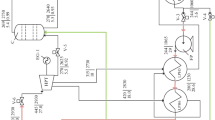Abstract
The basic technical characteristics of a conceptual design of micropellet fuel autonomous liquid-salt reactor MARS for low power levels are presented. Two variants with core service lives 15 and 60 yr are presented. It is shown that this concept satisfies the requirements which autonomous low-power nuclear power systems must meet.
Similar content being viewed by others
REFERENCES
P. N. Alekseev, N. N. Ponomarev-Stepnoi, S. A. Subbotin, et al., Enhanced Safety Nuclear Reactors (Analysis of Conceptual Designs), Énergoatomizdat, Moscow (1993).
M. Rosental, P. Haubenreich, and R. Briggs, “The development status of molten-salt breeder reactors,” ORNL-4812 (1972), USA.
P. Kasten, et al., “Graphite behavior and its effect on MSBR,” Nucl. Eng. Design, 9, No. 2, 157 (1969).
H. Machpherson, “Molten-salt reactors,” in: Proceedings of the International Conference on the Constructive Uses of Atomic Energy, Washington (1968), American Nuclear Society (1969).
P. Haubenreich and J. Engel, “Experience with the molten-salt reactor experiment,” Nucl Appl. Techn., 8, No. 2, 107–110 (1970).
T. Hudson, “Design and operation of the 1200°F heating system for the MSRE,” Trans. Amer. Nucl. Soc., 8, 147–153 (1965).
S. S. Abalin, V. A. Blinkin, V. M. Novikov, et al., “High-temperature liquid-salt reactors in nuclear- hydrogen power production,” Vopr. At. Nauk. Tekh., Ser. At.-Vodorod. Énerget. Tekhnol., No. 1, 10–15 (1978).
K. Furukawa and A. Lecoco, “New safe nuclear energy for the next century. Thorium molten-salt nuclear energy sunergetic,” in: Proceedings of Florence World Energy Research Symposium, Firenze, Italy, May 28- June 1, 1990.
M. Hery, M. Israel, P. Faugeras, and A. Lecoco, Etat d'ancement des recherches en France dans le domaine des CES. Conf 3980, Bruxelles, May 23- 24, 1977.
V. M. Novikov, V. V. Ignat'ev, V. I. Fedulov, and V. N. Cherednikov, Liquid-Salt Nuclear Power Systems. Prospects and Problems, Énergoatomizdat, Moscow (1990).
Lu. Yingzhjong, “Ordeals of Chernobyl and rejustification of inherently safe reactors,” in: Proceedings of Energy Workshop in IIASA, June 12- 16, 1987, Austria, Luxembourg.
Nuclear Power Production. Liquid-Salt Nuclear Power Systems. Prospects and Problems. Expert Assessments, Énergoatomizdat, Moscow (1989), p. 137.
Nuclear Power Production. Problems and Prospects. Expert Assessments, Énergoatomizdat, Moscow (1989), p. 122.
A. V. Andreev, I. G. Belousov, I. A. Belov, and V. S. Seryi, “Concept for the safest possible high-temperature reactor with liquid-salt coolant and bulk core,” Preprint IAÉ-5555/3 (1992).
A. V. Andreev, I. G. Belousov, and I. A. Belov, “Radiation safety assessment of high-temperature liquid-salt reactor with bulk core (VTRS-100),” Preprint IAÉ-5557/3 (1992).
W. Grimes, “Molten-salt reactor chemistry,” Nucl. Appl. Tech., 8, No. 2, 137–139 (1970).
M. Rosental, et al., “Molten-salt reactors history. Status and potential,” ibid., 8, No. 2, 123 (1970).
J. Koder, “Salt corrosion studies of molten-salt reactor program,” ORNL 4832 (1996), USA.
V. M. Novikov, V. N. Prusakov, V. V. Ignta'ev, et al., “Investigation of the corrosion resistance of structural materials for liquid-salt reactors,” Vopr. At. Nauk. Tekh., Ser. At.-Vodorod. Énerget. Tekhnol., No. 3(10), 31–33 (1981).
Yu. G. Degal'tsev, N. N. Ponomarev-Stepnoi, and V. F. Kuznetsov, Behavior of High-Temperature Nuclear Fuel under Irradiation, Énergoatomizdat, Moscow (1987).
D. Scott and E. Eatherly, “Graphite and xenon behavior and their influence of molten-salt reactor design,” Nucl. Appl. Tech., 8, No. 2, 78 (1970).
V. A. Karpov, Fuel Cycles and Physical Features of High-Temperature Reactors, Énergoatomizdat, Moscow (1985).
E. S. Glushkov, V. E. Demin, N. N. Ponomarev-Stepnoi, and A. A. Khrulev, Heat Release in a Nuclear Reactor, Énergoatomizdat, Moscow (1985).
V. I. Evseev, V. A. Karpov, A. M. Sobolev, et al., “Substantiation of the choice of physical characteristics of a VG-400 reactor,” Vopr. At. Nauk. Tekh., Ser. At-Vodorod. Énerget. Tekhnol., No. 1(11), 3–6 (1982).
V. A. Karpov and Yu. N. Udyapskii, “Analysis of the neutron spectra and nuclear properties of fissioning and rawmaterial isotopes used in high-temperature gas-cooled reactors,” Preprint IAÉ-3360/4 (1980).
S. N. Uvarov, Gas-Turbine Aircraft Motors in Power Production, Énergiya, Leningrad (1971).
Author information
Authors and Affiliations
Rights and permissions
About this article
Cite this article
Alekseev, P.N., Belov, I.A., Ponomarev-Stepnoi, N.N. et al. MARS Low-Power Liquid-Salt Micropellet-Fuel Reactor. Atomic Energy 93, 537–546 (2002). https://doi.org/10.1023/A:1020853930499
Issue Date:
DOI: https://doi.org/10.1023/A:1020853930499




